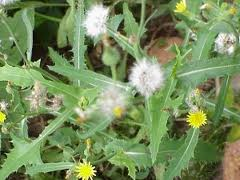Screening of some nigerian plants for pyrrolizidine alkaloids
Keywords:
Pyrrolizidine alkaloids; Ehrlich’s reagent; Plants; NigeriaAbstract
Pyrrolizidine alkaloids (PAs) are an important class of plant toxins whose hepato- and pneumo-toxicity have been extensively studied. Twenty three field plant materials (leaves, flowers, pulp, seeds) were collected, identified and screened for unsaturated PAs. A field test method with Ehrlich reagent was used. The absorbance of Ehrlich colour of the PAs and N-oxides were obtained at 565nm. Positive reactions were obtained from Borreria verticillata; Guiera senegalensis; Tamarindus indica; Crotolaria doniana; C. gorensis; C. glaucoides; C. mucronata; C. naragutensis; C. lachnosema and C. retusa. The occurrence of PAs are reported for the first time in C. doniana and C. glaucoides. B. verticillata, G. senegalensis and T. indica gave positive Ehrlich reactions which could be due to PAs or other groups giving positive Ehrlich reaction. A number of medicinal and food plants gave negative Ehrlich reaction. Further work is required to confirm and identify the alkaloids in the plants that gave positive reactions.
References
Adaudi, A.O., 1975. Dichepalatum barteri poisoning in Goats. Trop. Anim. Health Prod. 7, 56-57.
Abatan, M.O., Arowolo, R.O.A., Olorunsogo, O., 1996. Pathological effects of Lantana camara and Dichapelatum
madagascasiene in Goat. Trop. Vet. 15, 49-54.
ANZFA. 2001. Australia New Zealand Food Authority. Pyrrolizidine alkaloids in food: A toxizoological review and
risk assessment. Technical Report No. 2.
Crews, C., Stanin, J.R., Clarke, P.A., 1997. Determination of Pyrrolizidine alkaloids in honey from selected sites by
solid phase extraction and HPLC- MS. Food Additives and Contaminants. 14, 419-428.
Culvenor, C.C.J., Edgar, J.A., Smith, L.W., 1981. Pyrrolizidine alkaloids, in honey from Echium plantagineum L. J. of
Agric. and Food Chem. 29, 958-960.
Dalziel, J.H., 1937. The useful Plants of West Tropical Africa, Crown agents for Overseas Governments and
Administration, London, pp. 79-80.
Deinzer, M.L., Thomason, P.A., Burgett, D.M., Isaacson, D.L., 1977. Pyrrolizidine alkaloids: Their occurrence in
honey from Tansy Ragwort (S. jacobea L) Science, 195, 497-499.
Dharmananda, S., 2002. Safety issues affecting herbs: Pyrrolizidine alkaloids.
http://www.itmonline.org/arts/pas.htm.
Dickinson, J.O., Cooke, M.P., King, R.R., Mohamed, P.A., 1976. Milk Transfer of Pyrrolizidine alkaloids in cattle. J. of
Amer. Vet. Med. Assoc. 169, 1192-1196.
Edgar, J.A., Smith, W.S., 2002. Transfer of Pyrrolizidine alkaloids into eggs: Food safety implications. In: Natural
and Selected Synthetic Toxins: Biological Implications ACS Symposium Series 745. American Chemical Safety,
Washington, DC. Pp, 118-128.
Fu, P.P., Yang, Y.C., Xia, Q., Chou, M.C., Cui, Y.Y., Lin, G., 2002. Pyrrolizidine alkaloids tumorgenic components in
Chinese herbal medicines and dietary supplements. J. of Food and Drug Analysis, 10 (4), 198-211.
Hooper, P.T., 1978. Pyrrolozidine alkaloid poisoning. Pathology with particular reference to differences in animal
and plant species. In: Effects of Poisonous Plants on Livestock. R.F. Keeler, K.R. VanKampen and I. F. James
(Eds) Pp 161-176. Academic Press, New York.
Kellerman, T.S., Fourie, N., Naude, T.W., 1996. Plant Poisonings and Mycotoxicoses of Livestock in Southern Africa.
Oxford University Press, Cape Town.
Mattocks, A.R., 1986. Chemistry and Toxicology of Pyrrolizidine Alkoloids, Academic Press Orlando, FL.
Mattocks, A.R., Nwude, N., 1988. Pyrrolizidine alkaloids from Crotolaria lachnosema and C. naragutensis.
Phytochemistry, 27(10), 3289-3291.
Mattocks, A.R., Culvenor, C.C.J., Tandon, H.J., Prost, A., 1988. Environmental health criteria for Pyrrolizidine
alkaloids. World Health Organization Geneva. http://www.unchem.org/documents/ehc/ehc/080htm.
Molyneux, R.J., James, L.F., 1990. Pyrrolizidine alkaloids in milk: Thresholds of intoxication. Vet. and Human
Toxicology J., 32, 94-103.
Nwude, N., 1986. Poisonous Plants in Nigeria. Private Edition pp. 189.
Ober, D., Hartmann, N., 1999. Homospermidine synthase, the first pathway-specific enzyme of pyrrolizidine
alkaloid biosynthesis, evolved from deoxyhypusine synthase. Proc. in National Academic Sci. 96 (26), 14777-
Onyeyili, P.A., Chibuzo, G.A., Egwu, G.O., 1994. Accidental poisoning of sheep in an arid zone of Nigeria. World
Animal Review. Pp 78.
Otesile, E.B., Akpkodje, J.U., 1986. Clinical observations on Leucaena leucocephala (L.A.M) DE WIT Toxicity in
Nigerian White Fulani Cattle. Trop. Vet. Med. 4, 75-77.
Radominska –Padya, A., 2010. “Invited speakers” Drug metabolism Review, 42 (1), 1.
RIMS, 1992. Nigeria Livestock Resources. Four volume report submitted to the Federal Government of Nigeria by
Resources Inventory Management Limited.
Roulet, M., Laurini, R., Rivier, L., Calame, A., 1988. Hepatic Veno-Occlusive disease in newborn infant of a woman
drinking herbal tea. J. of Pediatrics, 112, 433-436.
Smith, L.W., Culvenor, C.C., 1981. Plant Sources of Hepatotoxic Pyrrolozidine alkaloids. J. of Natural Products, 44,
-152.
Steenkamp, V., Stewart, M.J., Zuckerman, M. 2000. Clinical and analytical aspects of Pyrrolizidine alkaloids
Poisoning caused by South Africa traditional medicine. Therapetic Drug monitoring, 22, 302-306.
Stegelmeier, B.L., Edgar, J.A., Colegate, S.M., Gardener, D.R., Schoch, T.K., Conlombe, R.A., Molyneux, R.J. 1999.
Pyrrolizidine alkaloid plants, metabolism and toxicity. J. of Natural Toxins 8 (1), 95-116.
Stillman, A.F., Huxtable, R., Consroe, P., Kehnen, P., Smith, S. 1977. Hepatic veno-occlusive disease due to
pyrrolizidine (senecio) poisoning in Arizona. Gastroenterology, 73, 349-352.
Sperl, W., Stuppner, H., Cassner, I., Judmaier, W., Dietze, O., Vogel, W. 1995. Reversible hepatic veno-occlusive
disease in an infant after consumption of pyrrolizidine containing herbal tea. European J. of Pediatrics, 154,
-116.
Tandon, H.D., Tandon, B.N., Mattocks, A.R. 1978. An epidemic of Veno-occlusive disease of the liver in Afghanistan.
Pathologic features. Amer. J. of Gastroenterology, 70, 607-613.

Published
How to Cite
Issue
Section
Copyright (c) 2013 T. A. Dare, N. Nwude, P. I. Rekwot, M. Mamman, B. O. Omontese

This work is licensed under a Creative Commons Attribution-NonCommercial-NoDerivatives 4.0 International License.



